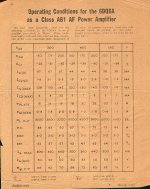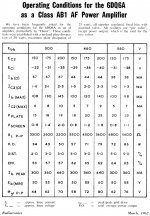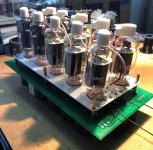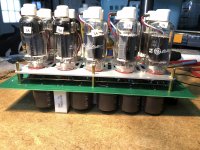Lower voltage, higher current allows using cheaper transformers. My main draw is the high power output available as triodes compared to traditional audio tubes. Another advantage is the tubes are usually less expensive.
If you drive them right and use them as pentodes, a pair could probably make more than 100W. Ask George
If you drive them right and use them as pentodes, a pair could probably make more than 100W. Ask George
Does anyone have experience with 12DQ6 tubes? I have searched it on the internet, but the information is scarce about this tube
You aren't gonna find much of anything. This was originally intended for use as a B&W TV HD final. No audio usage data was ever published since these types can't be used for Class A single ended designs, as the most linear part of the plate characteristics are well within red plate territory. If you're gonna use any of these TV HD types as audio finals, you'll have to draw your own loadlines, and use 'em as PP Class AB1 finals. A PP loadline can hit the most linear part of the plate characteristics without risking a burn out. The 6DQ6 should be a good audio performer. The 6BQ6/6AV5 certainly proved to offer some excellent sonic performance.
"What are the advantages of using a tube sweep amp like the 6DQ6 compared to most common output tubes (e.g. 6v6, el84, etc)?"
The big advantages for both audio and RF are that these TV HD types were designed to pull the bigamps through the horizontal deflection coils at low Vpk. For audio, that means low load resistances/phase. An OPT that doesn't have to match speaker loads to high resistances means an OPT with excellent performance that can be done more easily. On the downside, you may not be able to find an OPT with the right impedance match. You can still get lotsawatts while staying in Class *1, and even Class C1 is a design possibility for RF power amplification, so you don't have to drive grid current.
"How does it sound, does the tube sweep amplifier has it's own sound?" The 6BQ6GA/GTB design I did here: Le Renard showed performance comparable with the 6V6: mostly h3 with very little higher order harmonics. The open loop sound was a bit on the "aggressive" or "edgy" side, but gNFB cleaned that up. The 6L6-oids make more objectionable high order harmonics, and require more heroic NFB options to tame the nastiness (though they can also perform very well but there's a bit more work involved).
I was offered a 12DQ6 amp running in single ended outputting 12w. Is this true, can the tube output that much in single ended application?
Also, how is the distortion and linearity of this tube, say for example its max output is 12w and I need to get 10w out of it. Will I get many distortion and or clipping?
Also, how is the distortion and linearity of this tube, say for example its max output is 12w and I need to get 10w out of it. Will I get many distortion and or clipping?
I don't think that class C1 does make sense in AF applications. As the total conduction angle for both tubes is less than 360°, huge distortion numbers are to be expected.You can still get lotsawatts while staying in Class *1, and even Class C1 is a design possibility for RF power amplification, so you don't have to drive grid current.
Best regards!
6dq6 AB1
What are the advantages of using a tube sweep amp like the 6DQ6 compared to most common output tubes (e.g. 6v6, el84, etc)? How does it sound, does the tube sweep amplifier has it's own sound?
Attachments
What are the advantages of using a tube sweep amp like the 6DQ6 compared to most common output tubes (e.g. 6v6, el84, etc)? How does it sound, does the tube sweep amplifier has it's own sound?
Clean picture:
Attachments
Also, don't forget that like today, it's just what name the marketing department gave to certain things.
The fact that it's called a TV tube, doesn't automatically mean it can't be used for anything else.
The only reason EL84 and 6V6 are so popular has to do with what mainly guitar amp manufacturers were using at that time.
Even for audio tubes there are better choices in terms of quality, performance and efficiency.
Efficiency not just in terms of using less power. But there are other tubes using less heater currents.
Which automatically means being able to get more audio output power or running the tubes less hot and more linear.
The 6DQ6 with 1.2A heater and Pa of only 18W wouldn't be my first choice, unless I just have them laying around or so
The fact that it's called a TV tube, doesn't automatically mean it can't be used for anything else.
The only reason EL84 and 6V6 are so popular has to do with what mainly guitar amp manufacturers were using at that time.
Even for audio tubes there are better choices in terms of quality, performance and efficiency.
Efficiency not just in terms of using less power. But there are other tubes using less heater currents.
Which automatically means being able to get more audio output power or running the tubes less hot and more linear.
The 6DQ6 with 1.2A heater and Pa of only 18W wouldn't be my first choice, unless I just have them laying around or so
Last edited:
A TV horizontal sweep (line output) tube runs at full power all of the time. It is fed a constant ramp signal that generates a ramp current that drives a set of electromagnetic coils (the deflection yoke) in a TV set that "sweeps" the electron beam across the face of the CRT. As TV sets got bigger the sweep tubes needed to generate more and more power, so tube manufacturers made bigger and bigger sweep tubes, and often stuffed these larger guts into older tubes to consolidate manufacturing runs. Sometime in the 60's all GE sweep tubes got one of about 5 different "corporate" plate structures. This makes older design 12, 15 and 17 watt tubes all stuffed with the 18 watt plate structure pretty common. Sometimes older design 15 and up watt tubes can be found with the 24 watt plate inside. I bought over 100 25DN6 tubes which are rated at 15 watts. Over 80 of them have the same 24 watt plate that's found in larger sweep tubes, but some do have the old 15 watt plate, so knowing what's in the glass makes a difference.
A class amp, either SE or P-P will dissipate the most power at idle. The tube's dissipation goes down as the output power is increased. Unless you are cranking some EDM or techno music at the edge of clipping, the average power output of of your amp will be less than 10% of its rated output since most music has at least 20dB of dynamic range. This makes a class A amp (all SE amps) worst case for tube dissipation.
A P-P am will dissipate the least power at idle, and the most power somewhere between 30% to 100% of its rated power output, depending on how it's biased. This is why you are squeezing a 6DQ6 for all it's got to get 10 watts of audio out of it in SE, but they will live long and prosper at 100 watts per pair in P-P when biased close to class B.
All tubes have differences in manufacturing quality. A perfectly manufactured 20 watt tube may be happy at 30+ watts, while an identical tube that has some miss alignment or non uniform cathode coating may red plate at 15 watts. This is why I test my tubes to find their limits. A poorly aligned tube may red plate on one side while being cool on the other. Worse off is a tube that has one red hot spot. These tubes will not live long, while one that heats up evenly over the whole plate structure may be pushed beyond it's ratings.
A class amp, either SE or P-P will dissipate the most power at idle. The tube's dissipation goes down as the output power is increased. Unless you are cranking some EDM or techno music at the edge of clipping, the average power output of of your amp will be less than 10% of its rated output since most music has at least 20dB of dynamic range. This makes a class A amp (all SE amps) worst case for tube dissipation.
A P-P am will dissipate the least power at idle, and the most power somewhere between 30% to 100% of its rated power output, depending on how it's biased. This is why you are squeezing a 6DQ6 for all it's got to get 10 watts of audio out of it in SE, but they will live long and prosper at 100 watts per pair in P-P when biased close to class B.
All tubes have differences in manufacturing quality. A perfectly manufactured 20 watt tube may be happy at 30+ watts, while an identical tube that has some miss alignment or non uniform cathode coating may red plate at 15 watts. This is why I test my tubes to find their limits. A poorly aligned tube may red plate on one side while being cool on the other. Worse off is a tube that has one red hot spot. These tubes will not live long, while one that heats up evenly over the whole plate structure may be pushed beyond it's ratings.
of course, almost all of those horizontal scanning tubes can be used....Allan Kimmel posted an OTL circlotron many years ago...
I am currently in the process of building a circlotron OTL using 21LG6A sweep tubes loosely based on Alan Kimmel's original schematic: 100 Watt sweep tube Circlotron OTL (WIP)
I had to do a bit of shopping to find a sweep tube that had the most current capability for the most reasonable price. Most of the best ones have become far too expensive (including the EL509 that Kimmel originally specified). I also briefly checked the feasibility of using 17GE5 tubes (6DQ6 equivalents) but it would have required too many tubes relative to realized output power.
Attachments
Hi Jerdy, did you look at the 6hf5's? http://www.nj7p.org/Tubes/PDFs/Frank/127/6HF5.pdf
Last edited:
Hope I didn’t clean you out too much on spares for your project - I just bought 16 for a one-off plus spares. I need to experiment with the topology and techniques that I’ll be using for the 26LW6 monster using something less expensive and valuable, but still give me a nice working 300+ watt amp if everything goes well.
Anyone know if the 10JA5 (19W compactron vertical deflection) was ever available in a different heater voltage? I can’t find anything on Frank’s. I’m designing these into something and I need to know what other heater voltage taps to include, if any. 6.3, 14 or 15 would all make possible sense based on conventions used at the time. It will be a one-off and I have spares, but future-proofing to the extent possible is always a good idea. The 26LW6 amp will include a 36 volt option, and the 26DQ5 bass amp has 21V option ( to rewire for other similar types).
Anyone know if the 10JA5 (19W compactron vertical deflection) was ever available in a different heater voltage? I can’t find anything on Frank’s. I’m designing these into something and I need to know what other heater voltage taps to include, if any. 6.3, 14 or 15 would all make possible sense based on conventions used at the time. It will be a one-off and I have spares, but future-proofing to the extent possible is always a good idea. The 26LW6 amp will include a 36 volt option, and the 26DQ5 bass amp has 21V option ( to rewire for other similar types).
Anyone know if the 10JA5 (19W compactron vertical deflection) was ever available in a different heater voltage? I can’t find anything on Frank’s.
There is a 6 volt version, although I've never seen a data sheet. They appear to be more expensive than the 10 volt version.
jeff
The 10JA5 was not too common, and the 6JA5 even rarer. These were essentially the pentode half of a 6LU8 / 6LR8, so that's what you would use when designing a TV set unless you needed every last watt.
The 6LU8 / 6LR8 gets a lower dissipation rating due to the shared bottle. My experience is that they will red plate first on the side facing the triode, hence the lower rating.
The 6LU8 / 6LR8 gets a lower dissipation rating due to the shared bottle. My experience is that they will red plate first on the side facing the triode, hence the lower rating.
Yeah, I noticed that the plate curves were very close. It was actually a toss up between the JA5 and LR8 for one of the little projects I was working on, but ultimately decided on the JA5’s becuause I needed other valves anyway (integrated amp). And I can run the bias higher if I needed to because of the higher dissipation capability of the larger non shared bottle. The LR8’s would be better for the “simpler” 10-ish watt amp which won’t need any other bottles (2 stage vs 3, and no tone controls) and run off 340 volts from an isolation transformer. The plate to plate coupling will add another pole and might not let me get away with as much NFB as I wanted for the 25 wpc integrated amp, where I’ll be trying to push distortion down.
Hell, anything can happen between now and when I actually get stuff built. But at least I know now i won’t be wanting anything other than 6.8 and 11 volt taps on the power stage heater winding, and can go ahead and put the outer tape layer on the trafo and install the end bells permanently.
Hell, anything can happen between now and when I actually get stuff built. But at least I know now i won’t be wanting anything other than 6.8 and 11 volt taps on the power stage heater winding, and can go ahead and put the outer tape layer on the trafo and install the end bells permanently.
- Home
- Amplifiers
- Tubes / Valves
- Those Magnificent Television Tubes



